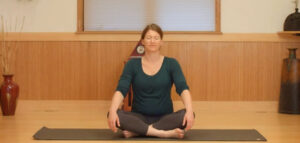
The vagus nerve plays a central role in your emotional and physical health. The vagus nerve extends from the brainstem down into your stomach and intestines, enervating your heart and lungs, and connecting your throat and facial muscles. Therefore, any yoga practices that stimulate these areas of the body can have a profound influence on the tone of the vagus nerve. Vagus nerve yoga helps you reclaim balance of body and mind using tools of mindfulness, conscious breathing, and physical postures.
“Healthy vagal tone can be thought of as an optimal balance of parasympathetic and sympathetic nervous system actions that allows you to respond with resilience to the ups and downs of life. Read on to learn 7 Vagus Nerve Yoga practices that will help you better manage stress and reclaim emotional balance.”
–Dr. Arielle Schwartz
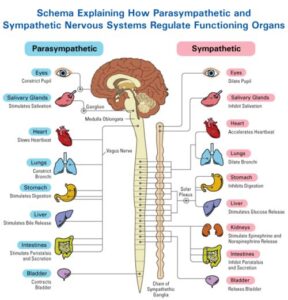
Your nervous system is built around the balance of two opposing actions. The sympathetic nervous system is associated with the fight or flight response that is the result of the release of cortisol (stress chemicals) throughout the bloodstream. The parasympathetic is associated with relaxation, digestion, and regeneration. These two parts of your autonomic nervous system are meant to work in rhythmic alternation, a process that supports healthy rhythms of alertness and restfulness that facilitate physical and mental health.
Unfortunately, chronic stress and unresolved trauma interfere with the balance between the sympathetic and parasympathetic functions of your nervous system. Because we live in a world that is over-stimulating and activating for the sympathetic nervous system, many of us need access to tools that help us engage the parasympathetic nervous system on a daily basis. The vagus nerve has an inhibitory influence upon the sympathetic nervous system activity. In other words, practices that stimulate the vagus nerve have a calming effect on your body and mind. It is also important to recognize that individuals with unresolved PTSD often resort to a primitive expression of the parasympathetic nervous system which can lead to symptoms of fatigue or depression. When left untreated, chronic stress and unresolved PTSD can disrupt your physical, mental, and emotional health (you can read more about Stephen Porges’ Polyvagal theory here). The good news is that practices that focus on stimulating the vagus nerve can help regain balance if you are either keyed-up with anxiety or shut down with fatigue.
An increase in vagal tone is linked to a reduction in inflammation and better prognosis in people suffering from chronic illness, anxiety, or depression. Vagal tone is measured in the changes in heart rate that occur with the breath. This is referred to as Heart Rate Variability or HRV. Healthy vagal tone involves a slight increase in heart rate on the inhalation and a decrease of heart rate when you exhale. Vagal tone can be thought of as an optimal balance of parasympathetic and sympathetic nervous system actions. People with higher HRV can move more easily from excitement to relaxed and can recover more easily from stress.
You can learn how to regulate the functioning of your vagus nerve with techniques such as altering the rhythm of your breath, practicing mindful body awareness, and exploring physical yoga postures to create greater choice about your level of arousal or activation. For example, with somatic awareness, you can alter you breathing rhythm to facilitate a state of relaxed alertness. This can help you tap into an optimal level of focus and attention that is often described as a being in the zone or the experience of flow that fuels your creativity. In addition, you can learn specific breath practices that help you relax in the evening and prepare for restful sleep.
The goal of a vagus nerve yoga practice is to become increasingly flexible…not of the physical body but of the nervous system. Research has shown tremendous benefits of yoga for increased vagal tone, stress reduction, and trauma recovery. This will help you become skilled at switching between sympathetic and parasympathetic nervous system with greater ease and choice. The following 7 vagus nerve yoga practices will help you develop healthy vagal tone, energize as needed, relax as desired, and reclaim balance in your life:
• Conscious Breathing: The most immediate way to change the balance of sympathetic and parasympathetic nervous system actions is with the breath. To counterbalance any over-stimulation of the sympathetic nervous system, vagus nerve yoga focuses on diaphragmatic breathing and extending the length of the exhale. Research has found that slow, rhythmic, diaphragmatic breathing increases healthy vagal tone. One form of yogic breathing is Ujjayi pranayama which creates a slight constriction in the back of the throat by engaging your whisper muscles. To learn this breath, exhale out of your mouth as if you are fogging up a mirror. Now, breath in the same manner but close your mouth and exhale out of your nose. You will notice the sound of your breath is louder which often sounds like the waves of the ocean. Start with an even count for your inhale and exhale. For even deeper relaxation, gradually increase the length of your exhale as compared to the inhale. For example, you might start out with a 4-count on the inhale and exhale the exhale to a 6 or 8 count exhale. This has a calming effect on your parasympathetic nervous system.
• Half-Smile: Engaging a “half-smile” is a valuable way to change your mental state and cultivate a serene feeling in the moment. Since the vagus nerve extends into the muscles of the face, you can increase vagal tone by relaxing the muscles of your face and then slightly turning up your lips. This practice helps to engage what Dr. Stephen Porges calls the “social nervous system,” the most evolved branch of the vagus nerve. As you smile, imagine your jaw softening and a relaxed feeling spreading across your face, your entire head, and down your shoulders. Notice the subtle changes in the quality of your thoughts and emotions.
• Open your Heart: You can gently stimulate the vagus nerve with yoga postures that open across your chest and throat. Try this gentle seated heart opening practice by bringing your hands to your shoulders. Inhale as you expand across the front of your chest, open your elbows wide, and lift your chin. Exhale as you contract your elbows in front of your heart and tuck your chin. Take several deep breaths in this moving meditation. Focusing on your inhalation in this breath pattern can be stimulating and uplifting. Allow yourself to expand into the open heart.
• Wake up and Stretch: If you are having a hard time waking up in the morning or if you are feeling tired and sluggish in the afternoon yoga can provide a gentle pick me up for your mind and body. Explore standing postures such warrior (virabhadrasana) pose to invigorate your mind and wake up your body. Notice your connection of your feet to the earth to stay grounded to energize yourself in a balanced manner. Allow the breath to remain rhythmic so that you stay rooted and connected to the sensations in your body.
• Release the Belly: You can work with connection of the vagus nerve as it passes through your belly. Find your way into a table position with your hands underneath your shoulders and your knees underneath your hips. If there is any discomfort on your knees you can place a folded blanket underneath you. As you inhale, begin to lift your head and your hips lowering your belly towards the floor as you move into Cow Pose. On your exhale lower your head and hips while you lift your spine into Cat Pose. Find your own timing of the movement with your breath. Repeat as many times as you like creating a gentle massage for you belly and spine.
• Self-Compassion or “Loving Kindness” Meditation: Self-compassion and the practice of “loving kindness” ask you to engage in the act of friendliness toward yourself and others. Research on that individuals who practice a loving kindness meditation revealed increased vagal tone, greater autonomic flexibility, an increased sense of social connectedness, and more positive emotions. Take a moment to reflect on a challenge you are facing in your life. Now, imagine someone else facing a similar challenge. Can you evoke a sense of compassion or kindness toward this other person? Notice how this feeling of compassion feels in your body. Wish them well. See if you can you extend that same quality of loving kindness toward yourself? Wish yourself well.
• Yoga Nidra: Restorative yoga can help you slow down and calm the nervous system. One classic practice is Yoga Nidra which is often referred to as “yogic sleep” or a meditation in relaxation. Yoga Nidra is the antidote to our stressful, modern lifestyle and offers an opportunity to restore body and mind through accessing the parasympathetic nervous system. Once you find a relaxing position lying on the floor, blanket, or yoga mat, cultivate awareness of your body and breath. Make space for whatever you are feeling, including any areas of tension, heaviness, or constriction. Allow yourself to remain still for 30 minutes for a deeply relaxing and nourishing experience.
Looking for more?
Check out all of my online offerings on Youtube for guided vagus nerve yoga and support for trauma recovery. If you would like to join me live on zoom, find out the date and sign up for an upcoming practice on my Therapeutic Yoga Page.
If you would like, join me for this Vagus Nerve Yoga Practice seated in a chair…

Within The Post Traumatic Growth Guidebook, you will find an invitation to see yourself as the hero or heroine of your own life journey. A hero’s journey involves walking into the darkness on a quest for wholeness. This interactive format calls for journaling and self-reflection, with practices that guide you beyond the pain of your past and help you discover a sense of meaning and purpose in your life. Successful navigation of a hero’s journey provides opportunities to discover that you are more powerful than you had previously realized. Click here to order the book on Amazon.
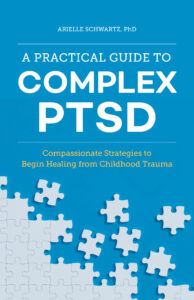
As a compliment to the Complex PTSD Workbook, A Practical Guide to Complex PTSD: Compassionate Strategies for Childhood Trauma, is meant to provide compassionate support for the process of healing from childhood trauma. You can think of it as a lantern that will illuminate the dark spaces and provide a sense of hope in moments of despair. The practical strategies you will learn in this book are taken from the most effective therapeutic interventions for trauma recovery. You will learn the skills to improve your physical and mental health by attending to the painful wounds from your past without feeling flooded with overwhelming emotion. My wish is to help you discover a new sense of freedom. The traumatic events of your past no longer need to interfere with your ability to live a meaningful and satisfying life. Click here to Order on Amazon.
The Complex PTSD Treatment Manual: An Integrative Mind-Body Approach to Trauma Recovery is written for clinicians who are helping clients navigate the consequences of repeated or chronic traumatization. This is a roadmap for therapy with clients who have experienced prolonged and chronic exposure to traumatic events. Click Here to order.
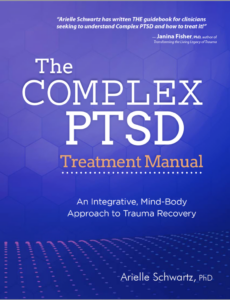
This book serves as a guide to help EMDR practitioners integrate somatic therapy into their sessions and to meet the growing interest in a synthesis of Somatic Psychology with EMDR Therapy as a comprehensive trauma treatment model. This integrative treatment model will teach you how to invite the client to sense and feel the body as a foundation for working through traumatic memories in a safe and regulated manner in order to facilitate lasting integration. Click Here to order on Amazon.
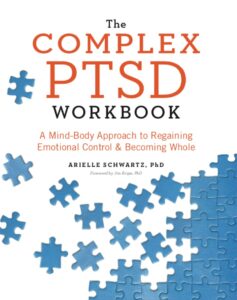
Connect to this post? The Complex PTSD Workbook is available on Amazon! Click here to check it out and increase your toolbox for healing. Whether you are a client or a therapist this book will offer a guided approach to trauma recovery.

Arielle Schwartz, PhD, is a psychologist, internationally sought-out teacher, yoga instructor, and leading voice in the healing of PTSD and complex trauma. She is the author of five books, including The Complex PTSD Workbook, EMDR Therapy and Somatic Psychology, and The Post Traumatic Growth Guidebook. Dr. Schwartz is an accomplished teacher who guides therapists in the application of EMDR, somatic psychology, parts work therapy, and mindfulness-based interventions for the treatment of trauma and complex PTSD. She guides you through a personal journey of healing in her Sounds True audio program, Trauma Recovery. She has a depth of understanding, passion, kindness, compassion, joy, and a succinct way of speaking about very complex topics. She is the founder of the Center for Resilience Informed Therapy in Boulder, Colorado where she maintains a private practice providing psychotherapy, supervision, and consultation. Dr. Schwartz believes that that the journey of trauma recovery is an awakening of the spiritual heart.
Photo credits: Thank you to Richard Flemming for your photography.

Arielle Schwartz, PhD, is a psychologist, internationally sought-out teacher, yoga instructor, and leading voice in the healing of PTSD and complex trauma. She is the author of five books, including The Complex PTSD Workbook, EMDR Therapy and Somatic Psychology, and The Post Traumatic Growth Guidebook.
Dr. Schwartz is an accomplished teacher who guides therapists in the application of EMDR, somatic psychology, parts work therapy, and mindfulness-based interventions for the treatment of trauma and complex PTSD. She guides you through a personal journey of healing in her Sounds True audio program, Trauma Recovery.
She has a depth of understanding, passion, kindness, compassion, joy, and a succinct way of speaking about very complex topics. She is the founder of the Center for Resilience Informed Therapy in Boulder, Colorado where she maintains a private practice providing psychotherapy, supervision, and consultation. Dr. Schwartz believes that that the journey of trauma recovery is an awakening of the spiritual heart.
Wisdom & Wellbeing Week 5: Trauma, Recovery and Somatic Intelligence at Blue Spirit Costa Rica